Echeveria species



Soft wooded
No secondary (woody) tissue being formed. The texture is fleshy and is soft, easy to cut.
Spreading-ascending
When a plant has stems that gradually grow upwards.This genus of succulents has symmetrical rosette fleshy leaves that form close to the ground or are on branched stems. The spoon to triangular-shaped leaves are light to dark green often edged with red and the bell-shaped flowers are pink, red to orange.
Echeveria species are naturally found from Mexico to southern and Central America extending to northwest Argentina growing in dry semi-desert regions or pine/oak forests, cloud forests or as epiphytes in rainforests. They are found in mountainous regions appearing on clefts or ridges and in cracks in boulders, up to an altitude of 2,500 m (8,202 ft) or more. They prefer a very well drained poor-fertile sandy-stony soil that is organic and tending acidic, with a pH range from 6.0 to 7.5. They grow in an open to exposed sunny position but will tolerate low light conditions and are drought and light frost tolerant.
Hen and Chicks are attractive hardy fleshy succulents that are grown for their colourful foliage and bright flowers. They are planted in rockeries or in crevices in retaining walls. They are commonly grown as a potted plant for indoors or outdoors or mass planted along borders. They are also used in wall gardens or roof gardens and are ideal for arid and succulent gardens requiring little care. They establish in one season from division and are long lived. In cold climates they are grown under glass where they are place in a bright sunny position and watered well during summer but very little in winter. They have a low water requirement (Scale: 1-drop from 3), responding to a pebble mulch and an occasional deep watering during dry periods.
I.D. 468
UK hardiness zone H2
Climate zones 8, 9, 12 - 24
USDA Zone 8-11
Note: These plants protect themselves from drying out in several ways. Firstly the outer leaves of the rosette dry out and form a protective barrier for the new growth underneath. Another method of protecting themselves from the sun is by producing a powdery or silvery layer over the leaves or change the colour of the leaves to pink or orange, blue or brown but if the light becomes less they revert back to green.
Echeveria (ech-eh-Ver_ee-a) species
Etymology
Genus:- Echeveria species - after Athanasio Echeverriay Godoy, 18th century botanical artist
Crassulaceae (krass-yoo-LAY-see-ee)
Stonecrops and Houseleakes
This family consists of perennial soft wooded herbs (succulents) and small shrubs.
Distribution
Mainly found in warm temperate climates but mainly in warm dry regions of South Africa, Madagascar and Central America. Others are founds in frosty or moist regions.
Diagnostic Features
The leaves are arranged opposite or spiral in a tight rosette and commonly fleshy with entire margins and no stipules. The leaves are commonly specialised for xerophytic conditions by having the surface covered in wax, hairs or bristles. In many cases they can reproduce vegetatively from fallen leaves, offsets and adventitious buds.
The bisexual flowers are composed of three; four and five parts with free fleshy sepals and membranous petals that may be fused at the base.
The stamens are arranged in 1 - 2 whorls with a fleshy nectar gland that are opposite each carpel. It may have a short or long style.
The ovary is superior with carpels that are fused or free and number the same as the petals and have numerous ovules in each.
The fruit is normally a star shaped or group of follicles with many tiny seeds that have little or no endosperm.
Note:
Many species are cultivated in containers or garden beds and under glass in cool areas. They are very popular with gardeners as they are easily propagated from cuttings and are adapted to dry conditions.
Plants are classed as succulents as they resemble each other. They have fleshy leaves and stems, which can store water. There are three families, Cactaceae, Crassulaceae and Mesembryanthemaceae in which all the species are succulents.
Most of the succulents are indigenous to semi-arid environments with long dry periods followed by a short wet period. The plants swell absorbing water during these wet periods and reduce evaporation by having a waxy cover over the leaves or the leaves are crowded together in a rosette. Hairs and spines (modified leaves) also reduce the evaporation of water and most succulents form rounded shapes to reduce the surface area of the plant.
The size of the plant and flowering period is difficult to predict with succulents as the environmental factors such as weather and light variations control the flowering period. Soil type and available moisture influence the growth.
This plant tolerates between USDA zones 8a to 11a and grows to 1 m (3 ft)
Fahrenheit 10 to 45 F
These temperatures represent the lowest average
Celsius -9.5 to 7.2 C
Attention
All photographs and data are covered by copyright. Apart from any fair dealing for the purpose of private study, research, reference or review, as permitted under the Copyright Act, no part may be reproduced by any means with out written permission. All inquiries should be addressed to plantfile.com attention Peter Kirkland.

Simple
The leaf that is not divided.
Obovate
A leaf that is broadest at the apex tapering towards the base.
Alternate
Leaves are arranged alternately along the stem.
Entire
A leaf margin with no irregularities (smooth).
Tubulate
A flower that forms a tube shape.
Panicle
Branched with large loose clusters.| Jan | Feb | Mar | Apr | May | Jun |
| Jul | Aug | Sep | Oct | Nov | Dec |
The flowers are up to 30 mm (1 1/8 in) long and have 5 expanding petals that are constricted at the mouth forming a campanulate to tubulate shape and contain 10 stamens. They are arranged in an axillary stalked raceme, cyme or panicle that arises from the leaf axils during summer.

Follicle
A capsular fruit that splits open down one side only and normally contains one seeds. "Hen and Chicks are attractive hardy fleshy succulents that are grown for their colourful foliage and bright flowers. They are planted in rockeries or in crevices in retaining walls. They are commonly grown as a potted plant for indoors or outdoors or mass planted along borders.
They are also used in wall gardens or roof gardens and are ideal for arid and succulent gardens requiring little care. They establish in one season from division and are long lived. In cold climates they are grown under glass where they are place in a bright sunny position and watered well during summer but very little in winter.
Cultural notes
Outdoor Cultivation
In warm regions with low humidity, cold and frost night's cacti and succulents grow well outdoors. The more humid atmosphere will limit the number of successful species. All of these plants require a very well drained soil and ample sunlight to succeed. Once established these plants require minimal maintenance.
Indoor Cultivation
Cacti and succulents grow well in glasshouses or near a sunny window with some ventilation tolerating a marked difference in day and night temperatures.
Cacti have a rest period during mid winter when they can be stored in a cooler area with reduced watering, once every two months. Protect the plants from freezing temperatures or extreme direct hot sunlight behind glass. All plants prefer a period outdoors during summer.
Watering
These plants normally have a wet and dry period. Watering should take place during the growing period of the plant. When new growth appears water well once a week and never water if the soil is already wet or place the pot in a saucer of water. Free drainage is essential for a healthy plant and succulents rot easily in moist humid conditions.
Problems related to watering.
Overwatering succulents results in leaves that wilt and discolour or stems that rot.
Under watering results in a sudden loss of leaves or brown and dry spots on the leaves. Leaves also fall if the water is too cold.
Pots
Both clay and plastic pots are suitable. The pot should fit the plant comfortably and not be too big as it may remain moist, rotting the plant. Water only when the soil has dried.
Re-pot only when necessary in to a slightly larger pot for older plants. If the plants are very large replenish the surface soil and thoroughly water.
Sow fresh seeds during early spring and maintain 21º C (69° F). Divide offsets throughout the year or separate plantlets.
Leaf or root cuttings can be taken during late spring.
Propagation by Seed (General)
Germination
In order for a seed to germinate it must fulfil three conditions.
1. The embryo must be alive (a viable seed).
2. The seed must have no dormancy-inducing physiological, physical or chemical barrier to germination; also the seed must be nondormant.
3. The seed must have the appropriate environmental requirements, water, temperature and oxygen.
The interaction between these requirements and dormancy is complex and may lead to different environmental requirements that avoid the dormancy of a seed.
Sowing Seeds in Containers
There are two general methods for germinating seeds.
1. Sowing seeds in a flat or germinating bed, through which seedlings are pricked-out then, transplanted into another flat with wider spacing or directly to an individual pot.
2. Sowing seeds by placing them in to flats with the appropriate spacing or into individual pots.
This method is normally carried out with medium to large seeds such as woody plants and plants that are difficult to transplant.
Seedling production normally occurs in a greenhouse / glasshouse, cold frames and on hot beds.
Method of Seed Sowing
Fine seed is sown in pots or flats that are no deeper than 70 to 80 mm. using a sterilised well-drained media (soil). Fill the container to 20 mm from the top and sprinkle sieved peat to 3 mm depth.
Press the media down level and firm with a piece of timber and then thoroughly moisten.
Mix the fine seed with washed sand and then sow thinly on the surface. These may be lightly covered with sand.
Larger seeds may be covered with media or a hole is dibbled and the seed is placed in the media.
Watering Methods
For watering you may either mist the containers from above or place the container in tepid water and allow the water to raise through the pot to the surface of the media, then drain away and do not fill to the top of the container.
Place a piece of glass over the pot and store in a protected warm environment (glasshouse).
Seeds germinate best in darkness so shade the containers if in direct sunlight.
After the seedlings have sprouted remove the glass and ease the seedlings into direct light.
When the seedlings are large enough prick them out and transplant into larger containers then place them in a shade house to harden off.
Many seeds have different methods of seed preparation for germination such as nicking or cutting the seed coat to allow water penetration, also placing seeds in hot water and allowing it to cool off.
This is particularly important as it is softening the seed coat.
Layering (General)
Factors associated with layering.
1. Nutrition
The stem is still attached to the plant and the intact xylem supplies water nutrition. To initiate roots on an intact stem requires certain factors.
2. Stem Treatments
Adventitious roots are induced by the interruption of downward flow of nutrients and organic material from the leaves. Roots occur as if it is a cutting.
3. Light Exclusion
The best results occur with the stem continuously being covered with rooting medium.
Blanching - the covering of a stem that has already formed.
Etiolation - the growing of the stem (elongating) due to the absence of light.
Both of these methods are employed either singularly or together and may require phloem interruption to induce root formation.
Physiological Conditioning
Timing of root induction normally occurs at the end of the growing season as the carbohydrates are moving towards the roots.
Root formation depends on, continuous moisture, ample aeration and a moderate temperature in the rooting area.
Uses of Layering
1. To propagate plants that naturally layer.
2. To propagate plants that doesn't root easily as cuttings.
3. To produce a large-size plant in a short time.
4. To produce a small number of good size plants with minimal propagation facilities.
Methods of Layering
Tip Layering
This method is used on plants that produce long arching canes. The tips of these canes are placed into a hole that is sloped on one side towards the plant. This is method is carried out towards the end of the growing period. The shoots are buried facing the blunt end of the hole.
The etiolated shoot form roots and a new vertical shoot occur.
Simple Layering
This type of layering is carried out during early spring with dormant one-year-old shoots or during autumn with mature new growth.
The branches are bent over to the ground and pegged in a hole. Root stimulating may be induced with, girdling, wiring, bending and notching.
The roots are produced through the first season and may be severe and lifted during autumn or the following spring.
It is advisable to stack the emerging shoot to maintain a good shaped plant.
Compound or Serpentine Layering
This is a simple layering method where the flexible stems are covered and exposed then covered again. This will produce several plants from the one branch.
Air Layering
This method is used to propagate tropical and sub-tropical plants. It is carried out during spring on the previous season's growth or in tropical conditions after the first new leaves are produced.
First, girdle or remove the bark on the stem about 20 mm (¾ in) long and ensure that the phloem and cambium is removed. Place sphagnum moss over the exposed branch and then covered with a piece of polyethylene film so that the folds join is facing down. The two ends are twisted around the branch and tied or taped up the branch so the water cannot seep in.
Aluminium foil may be also used for this procedure. The layer should be left till autumn, though this will depend on the growth rate of the plant.
When removing from the parent plant reduce the top part of the foliage in relation to the root size then pot up and place in a moist humid environment (misting bench). Harden off in a few weeks.
Mound Layering
This form of propagation is used in the production of rootstocks for, apple, pear, quince and gooseberries. The mother plant is planted in a small trench in rows one year before layering takes place.
The next spring the plants are cut back to ground level. Three to five shoots appear and when they reach 15 cm (3/5 in) a mixture of sawdust and loose soil is mounded half way up.
This action is carried out twice more, when shoots reach 30 cm (1 1/8 in) and during mid summer. In all cases the mounding should not exceed half the total hight of the shoot. Girdling 6 to 8 week into the growing period will encourage Roots to occur in the mound.
Layered shoots are cut away from the mother plant during autumn and planted in a nursery row.
Trench Layering
This is a form of layering used for woody plants that are difficult to root in mound layering. The method involves the mother plant being planted in a trench on a 30 deg. angle one year before layering.
The following year the plant is bent over and pegged in the trench flat. As new vertical shoots appear during spring they are systematically buried before the buds swell with a rooting medium of peat or sawdust soil mix. This causes etiolation and a second layer of medium should be applied to the shoots before the buds expand.
When the shoots reach 20 cm (¾ in) a final layer of medium should be applied.
At the end of the season the rooting medium is removed and the rooted shoots are cut from the mother plant.
Natural layering
Runners
These are stems that grow horizontal from the mother plant and form new plants from a node that form its own root system. When these daughter plants root up in the soil they are dug up and planted as a new plant.
Stolons
These are modified stems that grow horizontal to the ground or under the ground with nodes that can produce new plants as in a potato tuber. These can be cut away from the mother plant and form a new plant.
Offsets
This is a lateral shoot that forms from at the base of the mother plant. Often referred to in bulbs as bulblets or lateral branching in monocotyledons and appear as thickened stems and are removed close to the main stem. These natural methods are slow but microporpagation in aseptic culture has greatly enhanced production.
Suckers
The true meaning of a sucker is a shoot that comes from an adventitious bud on the roots, but generally it is referred to any shoots that arise from the crown of the plant. A sucker may be also seen as any shoot on a rootstock that is below the grafted section.
The method of removal is to dig out and cut it away from the mother plant with some roots attached to its base. It is then treated as a cutting, potted up and kept moist. This operation is normally carried out during the dormant period of the plant.
Crown Division
The crown is the part of the plant at the surface of the soil where new shoots arise. With lateral shoots the crown of some plants requires division when they become crowded.
Herbaceous perennials and multi-branched woody shrubs may develop large crowns that need dividing.
It is a simple method of propagation that is used by amateurs and professionals for a small increase in plants.
Plants that flower during spring to summer are divided during autumn and if flowering in summer to autumn they are divided in spring. The crown is dug up and cut with a knife in to sections, which has a shoot and abundant roots then planted or potted up. The crown may also be divided in some species by using a shovel to cut and dig sections out.
PEST
NAME
Aphids
Various Aphid Species
ORDER
Hemiptera
FAMILY
Aphididae
Description of the Pest
The common name varies and aphids may be referred to as black fly, greenfly, ant cows or plant lice.
These small insects have soft globular body that is from 1mm to 8mm long and vary in colour from green, yellow, black and pink, with the winged forms being elongated. Both adult and nymphs, have piercing and sucking mouthparts.
Aphids are found on buds, flowers, or leaves and stems, preferring soft new growth. On older leaves the aphids are found in protected positions, such as under the leaf. Certain species of aphids form galls as they suck sap and may be found on the roots of the plant. (E.g. Woolly aphids and Black peach aphids)
Most aphids possess a pair of characteristic tubular projections, known as cornicles; these secrete a pheromone and a waxy fluid, which is thought to protect them from some of their predacious enemies.
White exoskeletons, honey dew and sooty mould indicate the presence of Aphids
Balsam Twig Aphid (Mindarus abietinus) is greenish and covered in a white wax and is normally found on the young shoots of conifers bending and killing the needles. It is found on Abies and Picea species.
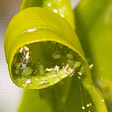 Aphid and their exoskeletons
Aphid and their exoskeletons 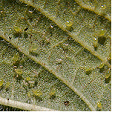 on underside of a leaf
on underside of a leaf
Black Citrus Aphid (Toxoptera aurantii) has a soft plump green body and the black coloured adults may or may not be winged. They feed in groups, curling leaves and producing honeydew attracting sooty mould.
Green Peach Aphid (Myzus persicae) is a soft plump green insect up to 0.2mm long and may be wingless. The nymphs are yellowish green and are responsible for spreading viruses in Dianthus species.
Spruce Gall Aphid (Chermes abietis) form cone shaped galls up to 12mm long resulting from the feeding. The wingless female adult lays eggs on the stems and the immature females overwinter on bud scales. Large infestation will weaken trees such as Picea abies and Pseudotsuga menziesii.
Tulip Bulb Aphid (Anuraphis tulipae) is small, waxy grey coloured and infests the underside of the bulb scales or rhizomes. They occur in the ground or on above ground parts and during storage.
Life Cycle
These insects have a Hemimetabolous life cycle, i.e. The nymphs resemble the adults.
During spring all eggs produced hatch as female nymphs. Adult Aphids are capable reproducing without fertilisation. The males are only produced in some species as the weather cools down, and the day length shortens.
Aphids are capable of giving birth to living young and large populations build up quickly during summer. Over crowding causes the aphids to become smaller, less fertile and produce more winged forms that can migrate to other host plants.
There are many different types of aphids and the life cycle varies from warm to cold climates.
Typical life cycles
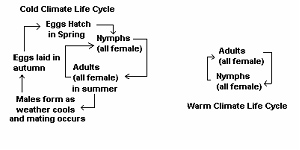
Distribution of the Pest
World wide
Period of Activity
In warm climates they are seen throughout the year, but aphids dislike hot dry or cold conditions and heavy rain will decrease the population. In cold areas aphid eggs are laid around a bud base or other protected areas of the plant during autumn and emerge as nymphs during spring, feeding on the new growth.
Numbers build up quickly in the warmer months of the year. Some species feed during winter on Sow thistles.
Susceptible Plants
There is a wide range of plants attacked, from roses to vegetables, shrubs and trees. Certain aphids attack a specific genus while others have a wide range of host plants. Many are capable of transmitting plant virus diseases.
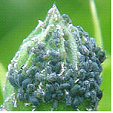 Adults and nymphs feeding
Adults and nymphs feeding 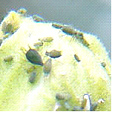 A colony of aphids
A colony of aphids
Acer species are attacked by several aphids including the Norway Maple Aphid (Periphyllus lyropictus) which is a greenish with brown markings and secret honeydew, preferring Acer platanoides. Other aphids include (Drepanaphis acerifolia) and (Periphyllus aceris) which are commonly found on the underside of leaves.
Acer species are also attacked by the Woolly Maple Aphid (Phenacoccus acericola) which covers the undersides of the leaves with a cotton-like mass
Alnus species are infested with the Alder Blight Aphid (Prociphilus tessellates) which is blue-black adult that forms woolly masses on the down-turned leaves. The nymphs overwinter in bark crevices.
Aquilegia species are attacked by several aphids including (Pergandeidia trirhoda) which is a small, flat cream coloured insect that is found on young branches and the underside of leaves.
Betula species may be attacked by the European Birch Aphid (Euceraphis betulae) which is small and yellowish or the Common Birch Aphid (Calaphis betulaecolens) which is large and green producing ample honeydew for sooty mold to grow on.
Callistephus species may be attacked by the Corn Root Aphid (Anuraphis maidi-radicis) causing the plant to become stunted, the leaves wilt and turn yellow. The aphids feed on the roots producing honeydew and are dispersed to other host by ants. It is also attacked by the Potato Aphid (Macrosiphum solanifolii).
Carya species are attacked by Gall Aphids (Phylloxera caryaecaulis) which is found on the leaves, twigs and stems forming galls and turning them black.
Chaenomeles and Gladiolus species, new growth and leaves become infested with the aphid (Aphis Gossypii)
Cupressus macrocarpa may become infested with the Cypress Aphid (Siphonartrophia cupressi).
Cyclamen species are attacked by the aphid (Myzus circumflexus) and (Aphis gossypii) which can infest healthy plants.
Dendranthema, Dianthus and Crocus species are attacked by several types of aphid including the Green Peach Aphid (Myzus persicae) and the Chrysanthemum Aphid (Macrosiphoniella sanborni).
Hibiscus species are attacked by the aphids (Aphis craccivora) and (Aphis gossypii), both congregate towards the branch tips and may cause leaf curl. Normally only seen in sub-tropical climates.
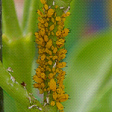 Aphids on a stem
Aphids on a stem 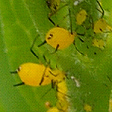 Mandevilla species
Mandevilla species
Larix species is attacked by the Woolly Larch Aphid (Adelges strobilobius). The winged adults deposit eggs at the base of the needles during spring and white woolly areas appear attached to the needles where the adult aphids feed. The young aphids overwinter in the crevices of the bark.
Mandevilla species is attacked by aphids that congregate towards the branch tips and may cause leaf curl.
Pinus species is attacked by several species of aphid including Pine Bark Aphid (Pineus strobi), Pine leaf Aphid (Pineus pinifoliae) and the White Pine Aphid (Cinara strobi).
Primula species are attacked by four species of aphid including foxglove, and green peach aphid.
Rudbeckia, Delphinium, Chrysanthemum and Helianthus species are attacked by a bright red aphid (Macrosiphum rudbeckiae).
Sorbus aucuparia is affected by the Rosy Apple and Woolly Apple aphid which attacked the foliage and young shoots.
Spiraea species are attacked by the Aphid (Aphis spiraecola) which feeds on the young shoots and flowers.
Tropaeolum species are attacked by the Black Bean Aphid (Aphis fabae), which is found in large numbers on the underside of the leaves, turning them yellow and causing them to wilt then die.
Tulipa, Iris, Freesia, Gladiolus and Zephyranthes species are infested with the Tulip Bulb Aphid.
Ulmus species are infected by two types the Woolly Apple Aphid (Eriosoma lanigerum), which curls and kills young terminal leaves and the Elm Leaf-Curl Aphid (Eriosoma ulmi) which occasionally attacks the trees.
Viburnum species are attacked by the Snowball Aphid (Anuraphis viburnicola). This aphid congregates at the end of the branches causing the leaves to curl and become deformed under which they hide.
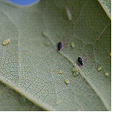 Aphids on Quercus robur
Aphids on Quercus robur
Damage Caused
Buds that have been attacked may not open, leaves and twigs become twisted or distorted and wilt. The aphids also produce honeydew, which is sticky and attracts sooty mould (fungus). This fungus forms a thick layer over the leaf, fruit or stems reducing the plants photosynthesis capability. The sooty mould spoils the plants appearance and its fruit, as does the insects white exoskeletons.
Control
Cultural Control
Aphids may be removed from a plant by hosing them off with water (limited success) or applying soapy water to aphids.. Another organic sprays can be efficient in controlling aphids. Aphids may also be removed physically by hand for small colonies on spine less plants. Species that live under ground are difficult to control but cultivation of the surrounding soil may help in controlling the infestation. (limited mainly to annual or commercial crops)
Reflective mulch around the plants also reduces numbers by repelling the insect this material is available commercially. (Reflective mulches are mainly used in market gardens for avoiding the Green peach Aphids) Resistant rootstocks are available to avoid some root feeding aphid of commercial plants, e.g. Vines and fruit trees
Biological control
Aphids are attacked by several insects includes parasitic wasps or predators such as ladybirds/ lady beetles, hover flies, lacewings, spiders.
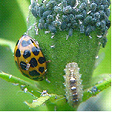
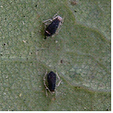 Parasitised aphids
Parasitised aphids
Chemical Control
Aphids may be controlled by spraying with a contact or systemic insecticide. The type of application used will depend on the plant is being attacked.
Aphids can be suffocated and therefore controlled with the use of e.g. White oil, Pest oil, Soapy water from soap such as Lux Flakes ®
Note
It is your responsibility by law to read & follow the directions on the label of any pesticide
Monitoring
Aphid are attracted by yellow colour and traps such as boards painted yellow and covered in glue or sticky substance will attract and trap the insects. There is also a commercially sticky yellow tape that can be attached to susceptible plants
Amendments by B. Sonsie Dip Hort Sc Burnley
PEST
NAME
Vine Weevil, Black Vine Weevil
Otiorbyncbus sulactus
ORDER
Coleoptera
Description of the Pest
The adult weevil is black with small brownish dots on its wing covers and is up to 9mm long. The white fleshy larva is legless up to 12mm long and both adult and larva have chewing mouth parts.
These insects have a Holometabolous life cycle, ie. When metamorphosis is observed during the pupal stage.


Appearance and Distribution of the Pest
This insect is found in Europe, North America and Australia and tends to appear in localised areas. The adult is distributed by flying with wind assistance and the larvae can infest other areas by soil movement or in infected stock.
Period of Activity
The adult is active during the warmer months of the year and normally have one generation per year. The larvae overwinter in the soil and the adults lay its eggs in soil surrounding the host plant.
Damage Caused
The adult chew on the leaves of the host plant and the larvae forms tunnels in corms or tubers. It also attacks roots particularly potted plants. Affected plants have a loss of colour in the foliage and stems die back or the plant collapses. Secondary infection enters the plant where weevil damage occurs.
Susceptible Plants
There is a wide range of plants attacked including Rhododendron species, Hydrangea species, Vitis species, blueberries, hops, apples,Cyclamen, Pelargonium, Sedum, Fuchsia and Begonia species. Plants that are already damaged, stressed or older are more likely to be attacked.
Cultural Control
Stressed plants can have there culture improved, but once the symptoms are seen and the plant collapses removal is the main course of action.
Biological Control
The larva may be attacked by patristic nematodes.
Chemical Control
There in no practical chemical control.
DISEASE
NAME
Bacterial Soft Rot
Erwinia species
Symptoms
Bacterial Soft Rot (Erwinia carotivora) infects the cell walls of the plant tissue causing the fluids to leak out making the areas soft and slimy. It commonly occurs at the base of the plant above or below ground level forming a soft dark patch and eventually the plant topples. It is not instantaneous and crops are infected during harvested they can rot in storage as the infection takes hold.
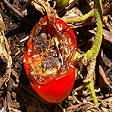
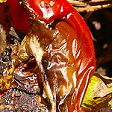
Soft Crown Rot (Pectobacterium carotovorum) is a bacterial disease that normally occurs during hot humid weather and is found in the soil and infects the roots and crown of the host normally through wounds. The symptoms are a rot that causes the plant to wilt and die and generates a strong offensive odour.
Source and Dispersal
It dwells in soil or in host plant and is dispersed on insects or animals from infected plants and can also be dispersed by water.
Favoured Conditions
It prefers warm moist conditions.
Affected Plants
It prefers succulent stems, buds, roots or fruit of a wide range of plants including vegetables, perennials and tuberous plants.
Caladium species are venerable to several bacterial diseases that infect tubers, including (Pectobacterium carotovorum) and (Pellicularia rolfsii) both causes soft rot.
Cactus species particularly larger ones are infected by the Bacterial Blight (Erwinia carnegieana). This destructive disease produces small circular light coloured spots that are water soaked along the margins with the underlying tissues turning black. It then turns blackish splits open and oozes brownish fluid. Infected branches collapse and the disease spreads quickly through the plant.
Dahlia species may be infected by Tuber Rot (Pectobacterium carotovorum) that attacks stored tubers causing them to form brown soft rot.
Delphinium species are infected with the Bacterial Soft Rot (Erwinia phytophthora) that causes the top of the plant to dry out, giving off a foul smell. The upper stems become soft and blackish, causing the plant to be stunted and eventually die to ground level.
Delphinium species are infected by the Soft Crown Rot (Pectobacterium carotovorum) causing the death of the plant it also attacks Sansevieria species causing them to rot at the base.
Orchids such as Cattleya, Cymbidium, Cypripedium, Dendrobium, Epidendrum, Oncidium, Paphiopedilum, Phalaenopsis and Zygopetalum species are infected by Soft Rot (Erwinia species).
Saintpaulia and Philodendron species are infected by Bacterial Blight (Erwinia species) which forms brownish to black rot water soaked spots that can appear all over the plant.
Non-chemical Control
As a preventive measure cultivate the surrounding soil to improve drainage, aeration and minimise weed growth. Do not over water and allow the soil surface to dry before rewatering. When handling the plants pick a dry period and take care to minimise damage. Collected produce should be stored in a cool dry environment as the bacteria is inactive in temperatures below 4ºC.
At first sigh of infection the plant should be removed and disposed off.
Chemical Control
There is no satisfactory chemical control. It is important to take preventive measures.
Note
Always read the label for registration details and direction of use prior to application of any chemicals.
Average Lowest Temperature : -1º C 30º F
USDA : 8, 9, 10, 11
This USDA (United States Department of Agriculture) hardiness zone chart can be used to indicate a plant’s ability to withstand average minimum temperatures. However, other factors such as soil type, pH, and moisture, drainage, humidity and exposure to sun and wind will also have a direct effect on your plant’s survival. Use this chart only as a guide, always keep the other factors in mind when deciding where, when and what to plant.
A plant's individual USDA zone can be found in the Plant Overview.
Climate Description
Warm to Sub-tropical
This overlaping zone has ample rain with high summer temeperatures and high humidity. Winters are mild. Pockets of sub-tropical climates exist within coastal warm temperate zones.
Frosts and droughts rarely occur along the coast.
Plant growth
Tropical and warm temperate native and exotic plants grow well.
| Dictionary | Growth Habit |
| Leaf Type | Botanic Flower Description |
| Leaf Shape | Flower Inflorescence |
| Leaf Arrangement | Fruit Type |
| Leaf Margin | Bark Type |
| Leaf Apex And Bases | Flower Description |